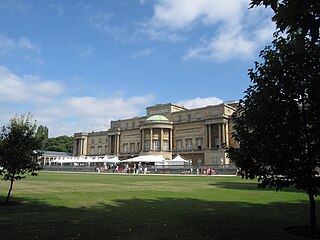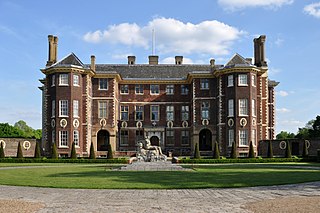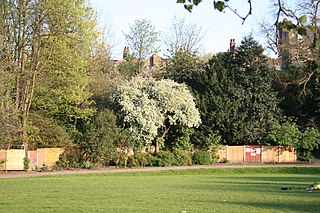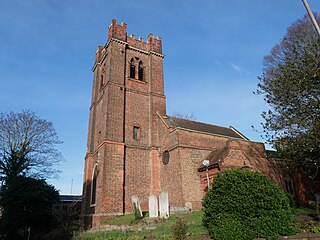
Greenwich is a town in south-east London, England, within the ceremonial county of Greater London. It is situated 5.5 miles (8.9 km) east-south-east of Charing Cross.

Belton House is a Grade I listed country house in the parish of Belton near Grantham in Lincolnshire, England, built between 1685 and 1687 by Sir John Brownlow, 3rd Baronet. It is surrounded by formal gardens and a series of avenues leading to follies within a larger wooded park. Belton has been described as a compilation of all that is finest of Carolean architecture, said to be the only truly vernacular style of architecture that England had produced since the Tudor period. It is considered to be a complete example of a typical English country house; the claim has even been made that Belton's principal façade was the inspiration for the modern British motorway signs which give directions to stately homes.

Lyme Park is a large estate south of Disley, Cheshire, England, managed by the National Trust and consisting of a mansion house surrounded by formal gardens and a deer park in the Peak District National Park. The house is the largest in Cheshire, and is recorded in the National Heritage List for England as a designated Grade I listed building.

Bowood is a Grade I listed Georgian country house in Wiltshire, England, that has been owned for more than 250 years by the Fitzmaurice family. The house, with interiors by Robert Adam, stands in extensive grounds which include a garden designed by Lancelot "Capability" Brown. It is adjacent to the village of Derry Hill, halfway between Calne and Chippenham. The greater part of the house was demolished in 1956.

Greenwich Park is a former hunting park in Greenwich and one of the largest single green spaces in south-east London. One of the Royal Parks of London, and the first to be enclosed, it covers 74 hectares, and is part of the Greenwich World Heritage Site. It commands views over the River Thames, the Isle of Dogs and the City of London.

Charlton is an area of southeast London, England, in the Royal Borough of Greenwich. It is east of Greenwich and west of Woolwich, on the south bank of the River Thames, 7.2 miles (11.6 km) southeast of Charing Cross. An ancient parish in the county of Kent, it became part of the metropolitan area of London in 1855 and is home to Charlton Athletic F.C. and Charlton House.

Buckingham Palace Garden is a large private park attached to the London residence of the British monarch. It is situated to the rear (west) of Buckingham Palace, occupying a 17-hectare (42-acre) site in the City of Westminster and forms the largest private garden in London. It is bounded by Constitution Hill to the north, Hyde Park Corner to the west, Grosvenor Place to the south-west, and the Royal Mews, Queen's Gallery, and Buckingham Palace itself to the south and east.

Longleat is a stately home about 4 miles (7 km) west of Warminster in Wiltshire, England. A leading and early example of the Elizabethan prodigy house, it is a Grade I listed building and the seat of the Marquesses of Bath.

Ham House is a 17th-century house set in formal gardens on the bank of the River Thames in Ham, south of Richmond in the London Borough of Richmond upon Thames. The original house was completed in 1610 by Thomas Vavasour, an Elizabethan courtier and Knight Marshal to James I. It was then leased, and later bought, by William Murray, a close friend and supporter of Charles I. The English Civil War saw the house and much of the estate sequestrated, but Murray's wife Katherine regained them on payment of a fine. During the Protectorate his daughter Elizabeth, Countess of Dysart on her father's death in 1655, successfully navigated the prevailing anti-royalist sentiment and retained control of the estate.
John Thorpe or Thorp was an English architect.

Maryon Park is an urban public park located in Charlton in the Royal Borough of Greenwich. It is situated on the A206 south of the Thames Barrier. There is access from Woolwich Road, Charlton Lane and Thorntree Road. It is part of the Maryon Wilson Park and Gilbert's Pit Local Nature Reserve.
Stiff Leadbetter was a British architect and builder, one of the most successful architect–builders of the 1750s and 1760s, working for many leading aristocratic families.
David Cunningham of Auchenharvie was a Scottish courtier and landowner. An absentee owner of Auchenharvie Castle, in London he was an administrator of royal rents to Charles I of England. A large number of his letters are preserved in the National Records of Scotland.
Sir Adam Newton, 1st Baronet was a Scottish scholar, royal tutor, dean of Durham and baronet.
Thomas Murray was a Scottish courtier, at the end of his life Provost of Eton.

Maryon Wilson Park is a public park in Charlton, in the Royal Borough of Greenwich in south east London. It is bounded on its northwest side by Thorntree Road; its southern-most, and highest, point is a gateway on to Charlton Park Road.
Charlton Park is a public park in Charlton, in south-east London, in the Royal Borough of Greenwich. It is situated east of Charlton village and Charlton House, and south of Charlton Park Road. Cemetery Lane bordering Charlton cemetery lies to the east, and the park is north of the Queen Elizabeth Hospital.

Charlton Cemetery is a cemetery, opened in 1855, covering 15 acres of ground in Charlton, south-east London. Situated in Cemetery Lane to the east of Charlton Park, the cemetery has retained its Victorian layout, and features two 19th-century chapels and numerous military graves.

St Luke's Church in Charlton, London, England, is an Anglican parish church in the Diocese of Southwark.

The Garden house at Charlton House, in the Royal Borough of Greenwich, is a summer house dating from the 1630s. The structure is often attributed to Inigo Jones, though there is no documentary evidence to support this claim. Its original purpose is unknown. In the 20th century, the building functioned as a public lavatory and by the 21st had become derelict and was placed on Historic England's Heritage at Risk Register. As of 2022, the garden house is undergoing restoration. It is a Grade I listed building.
















